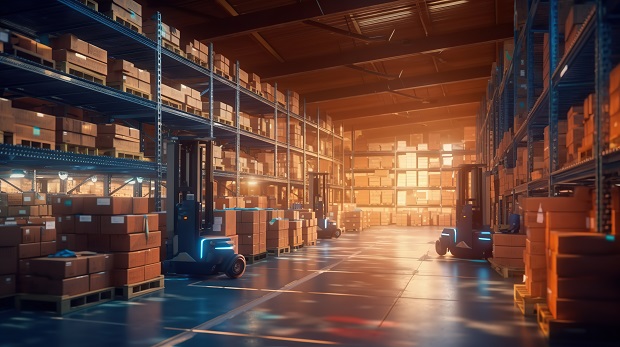A warehouse or distribution centre is the nerve centre of any logistics operation. Technology is giving rise to a new generation of intelligent warehouses. There are two main benefits of embracing automation and technology solutions: organisational effectiveness and efficiency. Opportunities abound to improve inventory visibility and delivery times while reducing operational costs.
 What is smart warehousing?
What is smart warehousing?
A smart warehouse leverages the latest technology to monitor inventory and optimize warehouse processes using automation and software solutions. These applications include automated vehicles, internet of Things (IoT), robotics, and artificial intelligence as well as full-scale warehouse management systems (WMS). More details on each of these are given below.
The benefits of technology solutions are many and include:
- Better productivity
- Improved accuracy and fewer errors
- More flexibility
- Increased customer satisfaction
- Improved safety
- Less paperwork
The significance of smart warehousing in 2024
Technology solutions will be an important differentiating factor in increasing competitiveness and retaining customers. Many warehouses still do not have any level of automation. A recent study by Zebra Technologies reports that both automation and worker augmentation solutions will be a key focus for decision-makers’ plans during the next five years. In Europe, RFID and location tracking technology usage is anticipated to increase for outbound operations with more than one in five planning to use them for packing (25 percent), inventory management (20 percent), and picking (19 percent). The study also found that the square footage of the average warehouse in Europe is projected to increase by 26 percent—more than in any other region—in the next five years.
Current trends and innovations in smart warehousing
- Data visibility and digitisation
Better quality real-time data is the key to warehouse efficiency. Data visibility means transparency, i.e., being able to track and trace items throughout the facility from sourcing through to delivery. Error-prone manual methods are hindering operations and limiting the growth of your business. Warehouses generate large amounts of data; software solutions help analyse and convert the collected data into actionable insights. Digitisation using technology tools streamlines existing processes, increasing productivity.
- Internet of Things (IoT)
IoT is a network of interconnected devices that can vary from computers to non-computer items that are embedded with sensors. Together, they can capture and exchange data in real-time. Connected devices deliver high visibility across all operations from receiving to picking and packing for dispatch. Tools may include mobile handsets and wearables that can send or receive information to and from users. IoT applications can also track the safety of machinery and asset health while improving safety.
- Equipment automation and robotics
- Automated guided vehicles (AGVs) are material handling systems or load carriers that travel autonomously throughout a warehouse, distribution centre, or manufacturing facility, without an onboard operator. AGVs navigate the movement of goods with minimal human assistance using floor stickers, radio waves, vision cameras, wires, magnets, or lasers. Obstacles and collisions are easily avoided.
- Warehouse robots may be semi-autonomous or collaborative robots or robotic arms that cut down on the time and resources spent on retrieving and transporting items around the warehouse. They eliminate tedious, manual work. Human workers can focus their time and energy on handling more complicated tasks.
- Drone cameras are used especially to manage inventory. They can deliver stock counts, identify missing items, conduct surveillance, and improve safety.
- Automated storage and retrieval systems (AS/RS) are designed to facilitate the storage and speedy retrieval of items and are usually used within a warehouse management system (WMS). They operate either as cranes or shuttles on fixed tracks to traverse product aisles and vertical heights.
- Artificial intelligence (AI) and Machine Learning
AI applications can enable machines to perform human-like tasks such as decision-making, speech recognition, spatial awareness, and visual perception. AI processes massive amounts of data using algorithms and statistical models. Machine learning is used to identify patterns and trends so that adjustments to systems and processes can be made with minimum human intervention.
- Digital twins
A digital twin is a digital virtual model of a physical object. You can test scenarios, optimize operations, and troubleshoot issues in a virtual warehouse environment before implementing changes in the real world. Digital twin technology allows you to oversee the performance of an asset, identify potential faults, and make better-informed decisions about maintenance and lifecycle.
How smart warehousing is revolutionising supply chains.
The cost of moving to a smarter warehouse is coming down as more solutions become available. The return comes with increased efficiency in inventory management, picking, packing, and shipping. By adopting and integrating automation and software solutions you will be better equipped to retain and service your customers.
 As pioneers in logistics consulting, we specialise in guiding companies through the complexities of warehouse optimisation. With the advent of intelligent warehouses, SCCG offers a range of consultancy services related to the integration of the technology, such as IoT, robotics, AI, and WMS.
As pioneers in logistics consulting, we specialise in guiding companies through the complexities of warehouse optimisation. With the advent of intelligent warehouses, SCCG offers a range of consultancy services related to the integration of the technology, such as IoT, robotics, AI, and WMS.
If you’d like to discuss how to optimise your warehouse, in order to facilitate growth, contact us at +44(0)1926 430 883 or info@sccgltd.com .




Comments are closed.